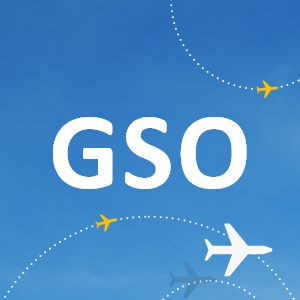
The Piedmont Triad Region (the Region or the Triad) in north-central North Carolina encompasses 12 counties and is anchored by three cities: Greensboro, Winston-Salem, and High Point. The area’s combined statistical area (CSA) is the 33rd largest in the country. Greensboro is the largest of the three cities. Home to approximately 1.7 million, the Region is served by Piedmont Triad International Airport (GSO or the airport). To the southwest is the larger Greater Charlotte area, home to nearly 2.8 million and the location of one of American Airlines’ hubs, Charlotte Douglas International Airport (CLT). To the east is the Raleigh-Durham area, with a population of about 2.1 million, and home to the state’s capital and Research Triangle Park, served by Raleigh-Durham International Airport (RDU). Based on passenger traffic, GSO is the third largest airport in North Carolina after CLT and RDU.

The Region and Its Economy
Since the mid-1900s, the Region’s economy has evolved from being centered largely on tobacco, textiles, and furniture to featuring a blend of trade, manufacturing, and service businesses, as well as its universities and colleges. Local industry is characterized by the production of machinery, electronics equipment, textiles and apparel, tobacco, and the provision of financial services. The region has significant strength in economic activity relating to transportation. The Piedmont Triad is home to nearly 200 aerospace companies.
| 2008 | 2019 | Change # | Change % | |
|---|---|---|---|---|
| Population (000s) | 1,565 | 1,689 | 124 | 8% |
| Total Employment (000s) | 923 | 982 | 59 | 6% |
The Airport, Its Services, and the Shadow Cast by CLT and RDU
GSO generally defines its catchment area to include 12 counties in north-central North Carolina. However, the airport faces significant challenges in attracting and retaining passengers due to the region’s proximity to CLT and RDU. The major drivers of consumers’ air service decisions are price and service levels (e.g., flight frequency or timing, aircraft size, and airline of preference). Consumers in the Triad take advantage of flight opportunities not only at GSO but at the other two major airports.
Passenger traffic at GSO is primarily origin and destination (O&D) traffic. Since the drop in 2009, O&D traffic has generally recovered, rising from 1.4 million to 2.1 million.
The airport has experienced a slow return of airline capacity to 2008 levels in the last 11 years. In 2019, GSO nearly regained all the capacity that it had provided in 2008. Available capacity changed little between 2010 and 2017. Since then, capacity increased by 24 percent.
GSO is the largest cargo airport in North Carolina based on landed weight. In 2019, total landed cargo and freight weight at GSO exceeded that at CLT by almost 20 percent and at RDU by nearly 70 percent.
Connectivity Analysis
Source: InterVISTAS analysis of Innovata schedule data from Diio Mi
Changing economic conditions and airline mergers (Delta Air Lines/Northwest Airlines, United Airlines/Continental Airlines, and American Airlines/US Airways) had a profound impact on consumer choice and connectivity at GSO, with reduced service suppressing connectivity below pre-Recession levels. However, the recovery in connectivity at GSO has been slightly faster than that of overall seat capacity and passenger traffic. Connectivity returned to 2008 levels by 2018 and continued to grow, driven by expanded capacity to major hubs like Hartsfield-Jackson Atlanta International Airport (ATL), Chicago O’Hare International Airport (ORD), and Dallas Fort Worth International Airport (DFW). As of 2019, GSO’s connectivity was 14 percent higher than 2008 levels.
Analysis of Air Service and Economic Variables
In the Triad, passenger traffic is relatively highly correlated with total regional employment. This means that as one variable rises, so does the other. As total regional employment increases, total O&D traffic at GSO also increases. However, correlation does not establish causation. It is not evident that changes in employment necessarily lead to or cause changes in O&D activity. The opposite could equally be true; changes in O&D traffic could bring about changes in regional employment.
The relationship between total regional employment and total O&D passenger traffic is positive, and the strength of the statistical correlation (R2 = 0.747) is relatively strong.[1]
Air Service Development and Regional Stakeholders
One key regional stakeholder is the Piedmont Triad Partnership (PTP), whose primary objective is to promote prosperity, growth, and economic development in the region. The PTP collaborates with the airport to support regional economic development initiatives. The PTP’s sectors of interest include biomedical and life sciences, technology, transportation and logistics, and automotive manufacturers, all of which rely on air service offerings in the region for their travel needs. Additionally, the region supports an economic development strategy centered on aviation and aerospace. GSO invested in the regional economy with the GSO aerospace “Mega site.”
Communicating the Airport’s Economic Impact
North Carolina conducted a state-wide study of the economic contribution of its airports. The report covered airport operations and estimated that GSO contributed
- 30,015 jobs
- $1.6 billion in personal income
- $8.6 billion in economic output
The airport uses the information from economic impact studies in communications with regional stakeholders; local, state, and federal government officials; and businesses it seeks to attract. GSO and other airports used the information to persuade the state of North Carolina to revise the formula it uses to distribute aviation grants. The airports argued that the economic impact based formula better represents the total value of the airport to the state.
[1] The correlation strengthens to 0.808 if the results from 2008 are excluded. Traffic then was affected by the presence of SkyBus, which ceased operations that year.
